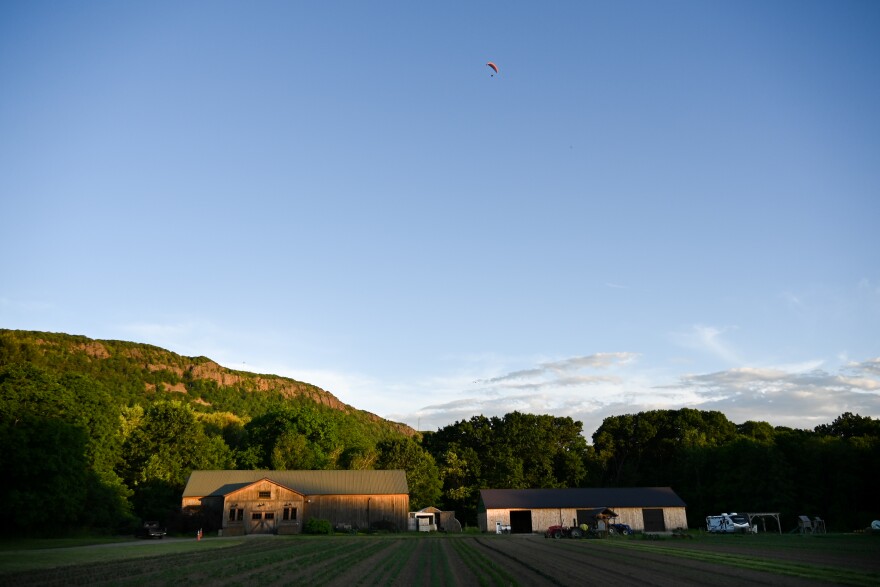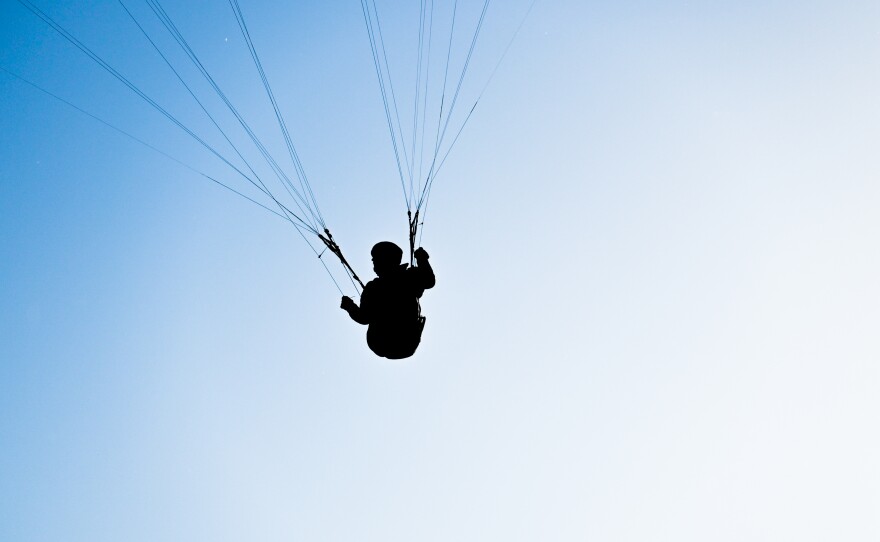The first time I hiked Mount Tom with John Gallagher, I said goodbye to him at the peak, and then he flew away.
Moments earlier, Brandon Russell, a hiker from Ludlow, had stumbled upon us. Now he stared after Gallagher in amazement.
“I just saw this guy jump off the side of a cliff with a parachute,” Russell said. “I've never seen that happen before. He's like 300 feet above us now already.”
Russell shook his head. “That's wild, man.”
Mount Tom, located in Holyoke, Massachusetts, isn’t an especially tall mountain, but it’s famous among paragliders for having some of the best flying conditions in the world. The mountain’s bare basalt cliffs and their specific orientation toward the sun create powerful thermal air currents that attract not only raptors, but also the people who want to emulate those large birds in flight.
Gallagher, 68, has been paragliding at Mount Tom for over two decades. No propeller, no motor — he’s lifted by the same rising columns of air that hold the turkey vultures aloft.
“We catch the thermal and up we go,” Gallagher said. “I've climbed to 7,000 feet here.”
To put that figure in perspective, 7,000 feet is about seven times higher than Mount Tom itself. It’s cold up there at cloud base. Gallagher wears a puffy winter jacket even in summertime. His orange and black parachute — he calls it his “wing” — is oblong, sort of pill-shaped. He hangs from it in a comfy hammock-like seat.
“It's still amazing,” Gallagher said. “I get up there sometimes, and I look up and I say, ‘Yep, I'm flying on strings and cloth.’”

Sometimes Gallagher launches from Mount Tom and flies to his house in Hadley, about 8 miles away. Sometimes he flies from Mount Tom all the way to Rhode Island or eastern Massachusetts (paragliders call that flying “cross-country”).
But some days Gallagher doesn’t go anywhere, just soars above the mountain with the bald eagles and broad-winged hawks.
Then he comes to a gentle landing on the mowed lawn of Pat Kusnierz, who watches Gallagher and other paragliders from her porch at the base of the mountain.
“I've seen them land on their butts. I've seen them hit a tree,” Kusnierz said one afternoon, while pilots congregated in her driveway before heading up the mountain.
Kusnierz is in her 60s, or maybe her 70s (she didn’t want to commit to a number). She’s a fixture of the local paragliding community — up to a point. I asked her whether she’d ever flown.
“Do I have ‘stupid’ tattooed on my forehead?” she replied.
Even though she’s never paraglided, Kusnierz is attuned to the same signs that the pilots are watching before they take off.
“I can sit here and tell you exactly what the turkey buzzards are doing. Exactly what those thermals are doing walking up the mountain,” Kusnierz said.

Another fixture of the local paragliding scene is Ben Perrault, 42. He runs Mountain View Farm, not far down the road from Kusnierz’s house. He’s been flying Mount Tom for eight years, ever since he became rather abruptly aware of what the paragliders were up to, when a pilot flew over his greenhouse and crash-landed in his strawberry field.
“I went to go yell at him,” Perrault said, “and I was like, ‘What the hell are you doing?’ And then I was like, ‘Whoa, what are you doing?’”
Perrault told me this story while hiking up the trail that leads to the Mount Tom launch area. It was a humid June evening and he was sweating profusely, not least because of the 50-pound pack on his back, filled with his parachute, harness, helmet and other gear. (The backpack becomes that hammock-like seat during flight).
Other pilots drive for hours to get to Mount Tom, but not Perrault.
“I can work till 5 and then run up in all my greasy clothes and still get a couple hours in,” he said.
And when Perrault lands, it’s usually in one of his own fields, strawberry crop on one side and snap peas on the other. Perrault’s daughter will often set out a cone for him to kick as he swoops in — a measure of a precise landing.
Flying came along at the right time for Perrault. He’d been working non-stop and feeling burned out.
“I wasn't happy, to be totally honest,” he said. “And the thermal flying was just a huge draw to me. It’s like, no power, you know — just you and the elements and the wind.”

Gallagher took Perrault on his very first flight off Mount Tom in a two-person, or “tandem,” paraglider. He was Perrault’s official flying mentor for years. Now they meet regularly at the launch site, and on this humid June day, Perrault stood at the edge of the cliff, assessing the strength of the wind. He pointed to his farm down below, explaining how one particular field with sandy soils gets “wicked hot.”
“And that thermal starts right there,” he said, “and then it sort of bubbles up and then gets sucked up the mountain.”
In other words, Perrault’s farm literally powers the air currents that carry him aloft. To measure those currents, pilots carry an instrument called a variometer, which beeps at varying intervals — the faster it beeps, the quicker the glider is gaining altitude.
The air was turbulent that evening, but once the wind had died down a bit, Gallagher, Perrault, and several other pilots took off, one after another, to soar in what they call the evening “glass off.” That’s when the sun gets low and the atmospheric temperature changes, and heat that’s been collecting in the Valley all day releases all at once.
After a while, Perrault called me from a 1,800-feet elevation.
“Every once in a while you get one of these hands-free nights,” he said, “and you can just let go of the controls and point into the wind and just hang out here and watch the sun go down. It's really beautiful.”
'Law of averages, you're going to have an incident'
Mount Tom is what’s known as a “technical launch,” and the riskiest part of flying here is the takeoff. The New England Paragliding and Hang Gliding Club, which oversees the launch site, has guidelines for how much experience pilots should have before they fly Mount Tom.
On July 8, a paraglider briefly lost control during takeoff and hit the ground hard, suffering two broken legs. He was transported off the peak in a Kubota tractor by the Holyoke Fire Department, which said it deals with about one paragliding incident a year.
Holyoke Fire Captain David Rex said the Mount Tom paragliders have been “good citizens,” cleaning up after themselves and focusing appropriately on safety. Still, he said, accidents with the sport are almost inevitable.
"Law of averages, you're going to have an incident," Rex said, "just because of the amount of times guys are going up there to fly off."
For the record, there are female pilots, but all the paragliders I met on Mount Tom were men.
While the Holyoke Fire Department is responsible for rescues on top of the mountain, it’s the Easthampton Fire Department that helps out down below when a landing goes wrong. Their worst recent incident was in 2020, when a pilot got caught halfway up the mountain, 80 feet high in a tree.

I had now climbed to the top of Mount Tom twice in a few days, only to have all my companions fly away. So when Gallagher offered to take me on a tandem flight — well, I paused for a moment, and then I was like, “Sure.”
The day of our flight, in her driveway, Kusnierz gave me — let’s call it a pep talk.
“When you go up, we're going to get you halfway up in the sky," she said. "And then John's going to hit the release, and you’ll just plummet.”
Kusnierz was laughing as she said it, and I was laughing, too. Still, “plummet” might not be the word a first-time paraglider wants to hear.
At the peak, there were a half dozen of us getting ready to launch, including John Mendes, who wore a puffy jacket and thermally insulated pants.
"You're married?" he asked me. "You'll be divorced if you become a pilot."
This was a refrain I’d heard from other paragliders: their obsessive need to drop all other commitments when flying conditions are good.
"I gotta leave early today," Mendes said. "But I kind of told her, 'I will, I promise you, I will be at the party.' She goes, 'You're not at the party, that's it! We're done. I've had enough of this flying.'"
Mendes was the first to take off, and he descended quickly — too quickly — barely skirting the trees at the edge of the landing zone.
“That was a nail-biter,” said one of the pilots, and Gallagher gave his assessment.
“Yeah, he went the wrong direction, he turned downwind and went too far out,” Gallagher said, shaking his head. “It was a whole bunch of what not to do on that one.”
On the bright side, Mendes might have just saved his marriage.
A pilot named Eli Chastek then launched, and at first he descended, too, but out over Easthampton he found a thermal powerful enough to lift him quickly. Within minutes he was soaring at 4,000 feet.
Then it was our turn. Gallagher clipped me into the harness and attached my harness to his. I was standing in front, him in back.
“When I say, ‘Run, run, run,’ just really barrel,” he instructed.
We waited a couple minutes for the breeze to pick up, and then I heard Gallagher’s voice behind me. “OK, let’s do it.”
He had me step forward and then back while he put enough tension on his flight lines to coax the wing into the air.

“Okay, let's go," he said. "Run, run, run, run, run, run.”
Let’s just say this is not something I usually do, go charging off the edge of a mountain, but the ground was suddenly gone from under my feet, and there was the cliff, behind us.
“Alright, don't be looking down,” he said. “Just look out where we’re going.”
We passed through a couple thermals, giving us a minor lift each time, sort of like an upward surge on a roller coaster ride. We turned and turned again, flying along the mountainside, but Gallagher couldn’t find a strong enough thermal to lift us up above the cliffs.
“OK,” he said. “I'm gonna gamble going out here, see if we can find a thermal on the way.”
Gamble: another questionable word for the first-time paraglider. And in this instance, no luck. We were heading down, away from the mountain toward Easthampton.
“Alright, looks like we're landing,” Gallagher said with a hint of disappointment. Then, about 7 minutes after we launched, we coasted in toward the landing zone behind Kusnierz’s house.
I was supposed to stand and run as we touched ground. And I think I ran, I really do, but before I could take more than a couple steps, I felt Gallagher’s weight behind me, and then he and I were both on the ground.
He was laughing a bit, saying, “No problem, no problem.” The wing collapsed into the ground in front of us, sort of like it was exhaling.
“All right,” Gallagher said, “let me get you up first.”
And here’s the weird thing: I’d just flown and landed, no worse the wear. It was plenty of an accomplishment for one day.
But from where I lay on the ground, I could see a pilot soaring thousands of feet above me, his wing an oblong speck against the clouds. And I wanted to be back in that sky.










